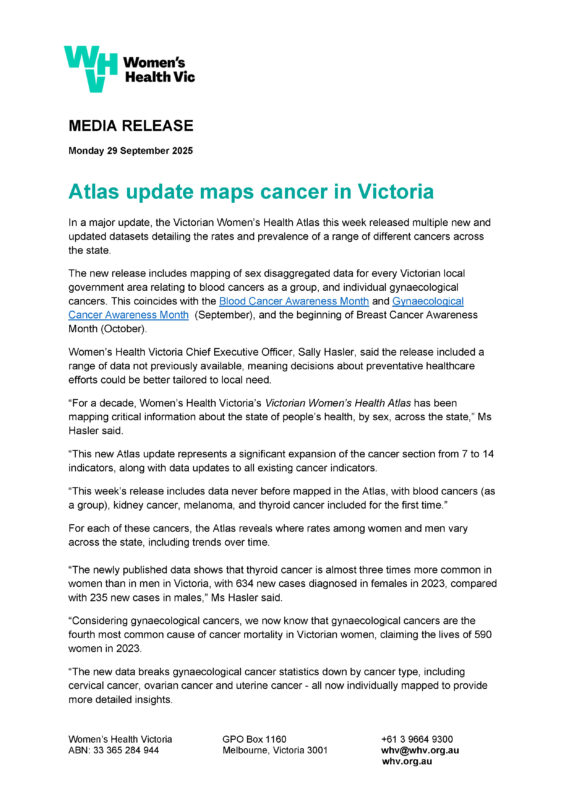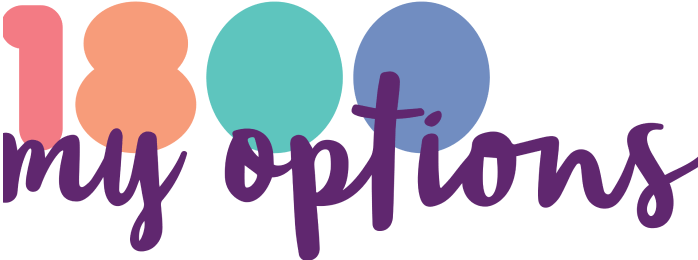In a major update, the Victorian Women’s Health Atlas this week released multiple new and updated datasets detailing the rates and prevalence of a range of different cancers across the state.
The new release includes mapping of sex disaggregated data for every Victorian local government area relating to blood cancers as a group, and individual gynaecological cancers. This coincides with the Blood Cancer Awareness Month and Gynaecological Cancer Awareness Month (September), and the beginning of Breast Cancer Awareness Month (October).
Women’s Health Victoria Chief Executive Officer, Sally Hasler, said the release included a range of data not previously available, meaning decisions about preventative healthcare efforts could be better tailored to local need.
“For a decade, Women’s Health Victoria’s Victorian Women’s Health Atlas has been mapping critical information about the state of people’s health, by sex, across the state,” Ms Hasler said.
“This new Atlas update represents a significant expansion of the cancer section from 7 to 14 indicators, along with data updates to all existing cancer indicators.
“This week’s release includes data never before mapped in the Atlas, with blood cancers (as a group), kidney cancer, melanoma, and thyroid cancer included for the first time.”
For each of these cancers, the Atlas reveals where rates among women and men vary across the state, including trends over time.
“The newly published data shows that thyroid cancer is almost three times more common in women than in men in Victoria, with 634 new cases diagnosed in females in 2023, compared with 235 new cases in males,” Ms Hasler said.
“Considering gynaecological cancers, we now know that gynaecological cancers are the fourth most common cause of cancer mortality in Victorian women, claiming the lives of 590 women in 2023.
“The new data breaks gynaecological cancer statistics down by cancer type, including cervical cancer, ovarian cancer and uterine cancer – all now individually mapped to provide more detailed insights.
“The new data published has revealed that uterine cancer is the most common gynaecological cancer in Victoria, with 926 new cases diagnosed in 2023.
“Uterine cancer rates vary widely across the state, and this can be visualised in the Atlas to support local health promotion efforts, as well as healthcare service design and delivery,” Ms Hasler said.
Five-year survival rates for gynaecological cancers in Victorian women (based on 2018-2022 data) are:
- 82% for uterine cancer
- 3% for cervical cancer
- 9% for vulval cancer, and
- 1% for ovarian cancer.
As of January 2024, there were an estimated 3212 Victorian women aged 50 and over with a history of uterine cancer diagnosed within the past 5 years, 643 with a diagnosis of ovarian cancer, and 429 with a diagnosis of cervical cancer.
Ms Hasler said that October is Breast Cancer Awareness Month, and the new data published on the Victorian Women’s Health Atlas showed that breast cancer is the most commonly diagnosed cancer in Victorian women.
“The new data reveals that in 2023 more than 5145 women received a new breast cancer diagnosis, as did 52 men,” she said.
“Breast cancer is the second most common cause of cancer mortality in Victorian women, claiming the lives of 822 women and 6 men in 2023.
“Positively, the five-year breast cancer survival rate for Victorian women is 92.5% and we know that catching it early exponentially improves survival rates.
“So, this October, I encourage all women aged between 50 and 74 to book in for their free breast screen if you’ve not had one in the past two years, and anyone 40 or over who has a higher individual risk.
“And as always, if you detect a change in your breasts – lumps, bumps, puckering, nipple discharge or change of shape, change of colour or anything else – please see your doctor,” Ms Hasler said.
The new data published in the Victorian Women’s Health Atlas this week also includes an update to all preventive screening indicators, including breast screening, cervical screening, and bowel screening.
To check out the new datasets, please visit Victorian Women’s Health Atlas.
For women and gender diverse people who’ve been diagnosed with cancer and would like to talk to someone who knows what it’s like, the Women’s Health Victoria’s Counterpart service provides free, confidential peer support: Peer Support – Counterpart





